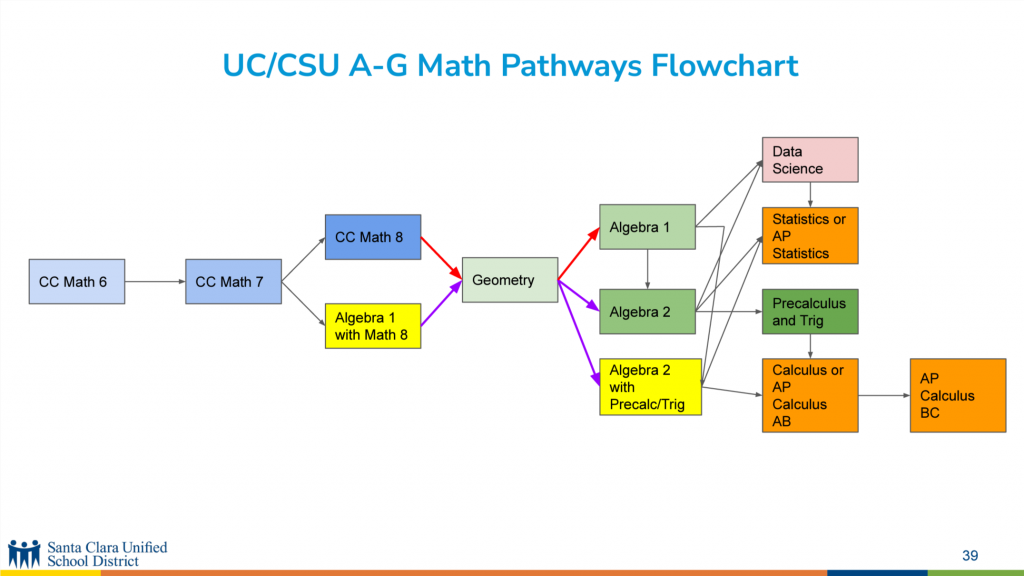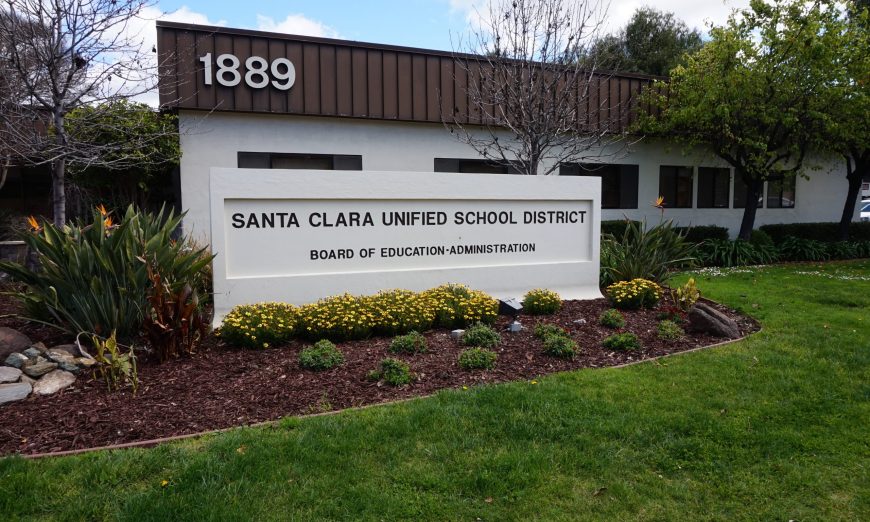Santa Clara Unified tasked the Math Pathways Committee to reevaluate students’ math journeys from 6th to 12th grade. The primary goal was to design pathways that would enable all students to pursue AP Calculus AB, AP Calculus BC, or AP Statistics in 12th grade without skipping courses or relying on external educational resources.
At the study session on Tuesday, Aug. 15, Superintendent Dr. Gary Waddell said his wish is to create a “world-class mathematics program that supports all youth and allows students to accelerate when they’re ready to do so.”
New Math Pathways
Currently, Santa Clara Unified allows middle school students to skip up to two math classes, which can lead to gaps in foundational knowledge. To take advantage of all the skipping, families must start down this path early. Additionally in high school, though there is no acceleration built into the system, families turn to external programs and summer school. Add the stress of placement tests, and navigating mathematics becomes unbelievably difficult for students.
Matt Baldwin, Director of Secondary Education, and Rachel Fainstein, Math TOSA, led the Math Pathways Committee, which was comprised of 12 teachers, eight principals, nine parents, one middle school counselor, one high school counselor, and Board Member Dr. Michele Ryan. That committee decided on “compaction points” that any student can use as an opportunity to speed up their math journey. There would be two compaction points, one in middle school and one in high school, where they would get two classes combined in one. The first compaction class would be Algebra 1 and Common Core Math 8 in 8th grade. The second compaction class would be Algebra 2 with Precalculus and Trigonometry in 10th grade.
Of course, students don’t need to do either compaction course to complete their UC/CSU A-G requirements. This pathway, for example, would be Common Core Math 6 through 8 in middle school and then starting with Geometry in 9th grade, Algebra 1 in 10th grade, Algebra 2 in 11th grade, and then they have options for 12th grade like Precalculus and Trigonometry, Statistics, AP Statistics or Data Science.
“This is what the majority of our students do,” said Fainstein. “80% of students don’t accelerate.”

With the new pathways, if a student wants to take advantage of the compaction points, all students still take Common Core Math 6 in 6th grade, then Common Core Math 7 in 7th grade, then the option for the first compaction point of Algebra 1 with Common Core Math 8. In high school, whether they took the compaction class or not, every 9th grader starts in Geometry. After Geometry, students can continue as normal or take another compaction class of Algebra 2 with Precalculus and Trigonometry in 10th grade. Lastly, students can take AP Calculus AB in 11th grade (some could double up with Statistics) and then AP Calculus BC in 12th grade.
Students can take both compaction points or just the middle school one or just the high school one. This way, depending on students’ development or confidence, they can decide to grasp an opportunity in either 8th grade or 10th grade or not at all, but the options are there and built into the system.
Currently, “if you didn’t accelerate twice in middle school, your high school class is determined for you,” explained Fainstein. “Now students who are 9th graders in Geometry but want to get to Calculus AB can choose to take that compacted class and still get there within our system.”
The Rationale
To address some concerns already out there, the committee said they believe all 6th graders should take Common Core Math 6 because it is essential for success in high school courses. With a better foundation with an emphasis on procedural fluency, application, and conceptual understanding they hope that math proficiency will improve overall. And the reason for compacting Algebra 1 and Math 8 is that they have a lot of overlap, making them easier to teach together.
Having 9th graders share the same starting point in Geometry also made better sense because Geometry uses middle school math, so they get another year to practice these lessons and get the prerequisite skills for Algebra. And their reasoning behind compacting Algebra 2 with Precalculus and Trigonometry is that they have significant overlap too.
The committee decided on these shared starting points because of a joint study from SVMI and Stanford which shows that heterogeneously grouped students have better outcomes and build a better community for students. However, some parents are concerned that this will lead to more advanced students being shouldered with a peer tutor role.
Streamlining the math pathways across the District also lessens the stress on placement tests since students no longer need to prove their proficiency to skip each class. With the new pathways, they’re not skipping the content and instead learning that content in the compacted courses. Where placement tests have been a barrier for students trying to get ahead, the new pathways open opportunities that students can use at multiple points in their math journey since anyone can take a compacted course. In the new pathways, “placement will be suggested based on nationally normed assessments (i-Ready and MARS Tasks); the decision to enroll will ultimately be up to families,” says the presentation.
According to Fainstein, students already on their math journey in Santa Clara Unified can stay in whatever courses they’re already taking but if the new pathways are a better fit, they can do that instead. She wanted to make it clear that they are not going to make students repeat courses they already tested out of.
Board President Vickie Fairchild asked about families who still choose to use outside programs to get ahead. Baldwin said they would support students since they are still allowed to take advantage of that resource. However, having the in-system option of reaching AP Calculus BC will hopefully reduce the need for families to rely on outside programs. In a survey of 1,500 students in 6th – 12th grade, they found that 68% of students in accelerated math courses reported getting private math support (tutoring, RSM, Kumon, etc). According to the presentation external tutoring and additional instruction can cost $5,000 to $10,000 annually.
“This disparity is creating an equity issue, as only those who possess the means to access such resources benefit from the system,” says the agenda.
Board Member Jodi Muirhead agreed with most of the committee’s recommendations but was concerned about more elite classes like honors. What about them? Fainstein argued that all students should have access to the level of instruction that is expected in honors classes – even though there is no standard to how honors classes are run, and honors courses don’t give an advantage for college admittance. Honors doesn’t equal acceleration, added Baldwin.
Similarly, Fairchild said she got emails from staff and families concerned that the new math pathways wouldn’t be a good fit for every student. Baldwin said the committee worked hard to consider as many students as possible and this pathway best met the needs of 14,000 students. He pointed out that there were only 82 AP Calculus BC students last year and admitted that gifted and driven students may require a different approach. Fairchild argued that they shouldn’t ignore those 82 students and warned that families will still choose outside programs to get their students ahead. Fainstein reiterated that they can’t stop families from seeking outside acceleration. However, if students do both compaction points, they can still reach AP Calculus BC without the barrier of the placement test or skipping courses, which was the task the committee was given.
Next Steps
Looking ahead, Dr. Waddell assured the Board that they are still early in this process and want to hear from the community. There will be five live Math Success Parent Nights at each middle school where families with students of any age can learn about the new math pathways. There will also be teacher information sessions. A website with important information and frequently asked questions is already in the works.
When Board Member Andy Ratermann asked when the committee hoped to start the math pathways, Fainstein said want to get students on the enhanced math pathways as soon as possible so they are aiming for as early as next school year. They will start with two cohort classes – one in middle school and one in high school for the compaction courses since that’s where the biggest change would be.
The Santa Clara Unified Board meets next on Thursday, Aug. 24. Meetings are live-streamed on the District’s YouTube page and agendas are posted on their website.






